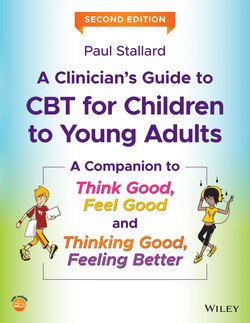Читать книгу A Clinician's Guide to CBT for Children to Young Adults - Paul Stallard - Страница 16
CBT with children and young people with learning difficulties
ОглавлениеThere is evidence that CBT can be effective with young people with learning difficulties, particularly those with high‐functioning autistic spectrum disorder (ASD; Perihan et al. 2019). For example, studies have demonstrated that CBT programmes for young people with ASD do have a beneficial effect on reducing symptoms of anxiety (Storch et al. 2013; Van Steensel & Bogels 2015; Wood et al. 2009) and OCD (Vause et al. 2018).
Researchers have highlighted how CBT needs to be modified to accommodate the young person’s specific learning difficulties (Attwood & Scarpa 2013; Donoghue et al. 2011). This involves attending to factors such as communications/language abilities, interpersonal/social abilities, cognitive and behavioural inflexibility, and sensory sensitivities (Scarpa et al. 2017). In terms of communication, adaptations might include the use of simple, precise, and concrete language and the greater use of more non‐verbal visual techniques such as pictures, worksheets, or visual prompts (e.g. writing the aim/focus of each session on a board). The young person’s special interests can be integrated into the intervention through the development of metaphors or use of rewards. Interpersonal skills with young people with ASD maybe more limited, so greater attention needs to be paid to the assessment and development of core skills such as ‘mind reading’ to aid understanding of how people might think and feel. Once again, the process can be made concrete through the use of role plays. Cognitive flexibility can be promoted using self‐talk where different options are verbalised and modelled or through multiple choice questions which encourage awareness and consideration of alternative strategies. For behavioural inflexibility, interactions during clinical sessions may need to be modified to be more consistent with the expectations of the young person. For example, Donoghue et al. (2011) note that the usual social exchanges at the start of therapy sessions may create anxiety and suggest that the therapist adopts a more task‐focused approach. Similarly, anxiety associated with change can be minimised by using the same room to meet, having a clear session routine/structure, and establishing a clear length for the meeting. In terms of sensory issues, it may be necessary to reduce the length of the session, change the lighting, remove visual material from the room, or use relaxation skills to help reduce sensory overload. Finally, generalisation from clinical sessions to the young person’s everyday environment can be facilitated through the involvement of parents, mobile phones to send prompts and reminders, and digital cameras to capture difficult situations (Donoghue et al. 2011).
Research with young people with other disorders is more limited. For visually impaired young people, tactile prompts can be used to remind the young person of the steps involved in managing anxiety (Visagie et al. 2017). For those with moderate learning difficulties, skills such as problem solving can be broken down into simple steps (Stop, Plan, Do) and limited decision‐making options (e.g. you can do either X or Y).
